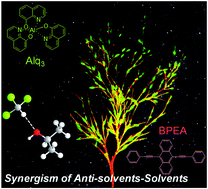Epitaxial growth of dual-color-emitting organic heterostructures via binary solvent synergism driven sequential crystallization†
Abstract
The controlled construction of organic heterostructured architectures derived from molecules with similar nucleation thresholds and concentrations has been rare and remains a great challenge. Herein, we report a sequential epitaxial growth to synthesize dual-color-emitting organic heterostructures with 9,10-bis(phenylethynyl)anthracene (BPEA) microwire trunks and tris-(8-hydroxyquinoline)aluminium (Alq3) microstructure branches by an anti-solvent induced sequential crystallization strategy. During the epitaxial growth process, the hydrogen-bonding interactions of the anti-solvent and solvent cause a large change in the solubility and crystallization rate of BPEA and Alq3 molecules in the mixed system, which facilitates sequential crystallization of organic molecule pairs with similar nucleation thresholds and concentrations into desired heterostructures by manipulating the synergism of anti-solvents and solvents. The Förster resonant energy transfer process in heterostructures could be modulated by varying the structure of heterostructures, such as the shape, amount and angles of the branches. The present synthesis strategy provides a unique insight into the detailed formation mechanism of complex organic heterostructures, further guiding the construction of more functional heterostructure materials.



 Please wait while we load your content...
Please wait while we load your content...